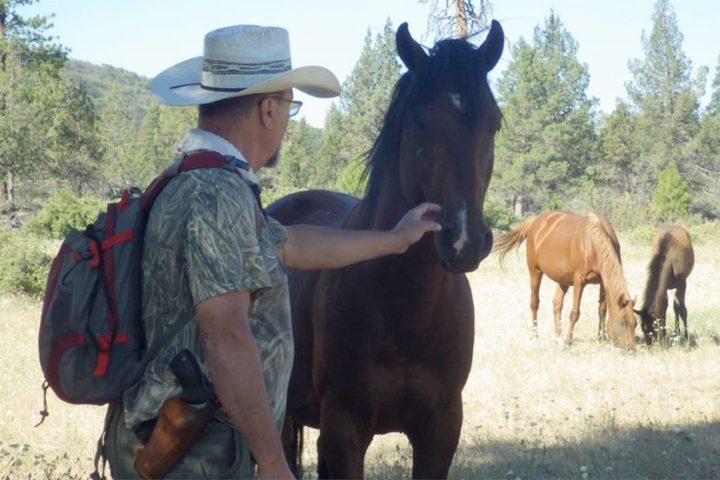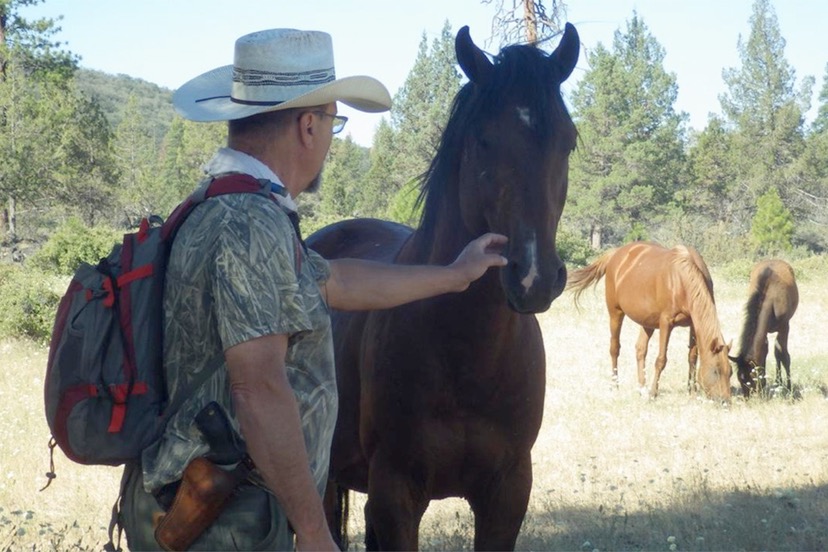Catastrophic wildfires are now releasing hundreds of millions of tons of greenhouse gases into our atmosphere, thereby accelerating climate change. Native species American wild horses can reduce the amount of greenhouse gases that are released into the atmosphere annually by catastrophic wildfires.
Our planet and all of nature is now being subjected to the effects of global climate change, which arguably has been brought about in part by mankind’s activities on the planet. One of the largest contributors to climate change, aside from impacts stemming from solar radiation, are carbon compounds (greenhouse gases) that are being introduced into the atmosphere.
Most people, including some scientists, often focus considerations on the obvious sources of carbon compounds resulting from the activities of mankind, such as industrial and tailpipe exhaust pollutants. And recently, the greenhouse gases resulting from the melting of the permafrost, which releases methane among other gases. Nevertheless, due to changes in public land management policies over the past decades, one of the largest impacts on climate change has evolved. Incredible volumes of greenhouse gases produced by catastrophic wildfires have been largely overlooked and understudied by scientists and our government, and I for one must ask, why?
I believe that the simple answer is that; the evolution of catastrophic wildfire is an embarrassment to the people and agencies who failed to recognized the flaws in their science and policies, and who now bear some responsibility for the development of these disastrous wildfires and the hundreds of millions of tons of greenhouse gases they produce annually, just in America.
Catastrophic wildfire in California alone was responsible for a cumulative CO2 emission for the year — as of September 13, 2020 — of about 83 million metric tons, according to data from the European Centre for Medium-Range Weather Forecasts.
The mismanagement of our natural resources, including public lands, forests and wildlife — especially native species herbivores — by government agencies over the past decades has arguably led to the evolution of catastrophic wildfires.
Catastrophic wildfires and resulting greenhouse gases stem, in part, from depleted and mismanaged populations of native herbivores. Generally, an herbivory relates to animals known as ‘herbivores’ that eat plants and plant materials. Native species herbivores in north America, such as wild horses, have evolved as ‘symbiotic grazers’ that maintain native species vegetation to nominal levels while concurrently performing one of several critical symbiotic roles; the reseeding of the same plants.

Native species American wild horses are a ‘keystone species’ and are unique in their ability to accomplish both maintaining wildfire fuels to nominal levels, while also reseeding the same plants and restoring soils through their nutrient and biome-rich droppings. This process also keeps carbon compounds sequestered in soils and plants. Invasive species — cattle, sheep and goats — cannot perform any effective reseeding of the plants they graze because of their complex stomachs, which digest virtually all of the seeds they consume.
Therefore, wildfire grazing in environmentally sensitive areas, such as wildfire-prone wilderness areas, or areas with threatened and endangered flora, can best be accomplished using native species American wild horses.
A scientific study published by the American Association for the Advancement of Science supports the thesis that the depletion of large-bodied herbivores leads to the evolution of catastrophic wildfire. According to Science: “By altering the quantity and distribution of fuel supplies, large herbivores can shape the frequency, intensity, and spatial distribution of fires across a landscape.”
Catastrophic wildfires burn at abnormally hot temperatures as a result of being highly-fueled by excessive one-hour-class fuels (grass and brush) now prodigious across the western American landscape. Prior to the recent decades of mismanagement of native species herbivores by agencies influenced by flawed and obsolete science, one-hour-class fuel loading across the landscape was maintained at nominal levels by adequate populations of large-bodied native species herbivores, such as wild horses, deer and elk.
Today, populations of deer and elk are severely depleted from what they had been in past decades. California and Oregon together have lost about 2 million deer over the past 50 years. And the populations of native species American wild horses, that once numbered about 2 million animals in the early 1900s, are nearly down to numbers that should qualify them as an endangered species, with only about 20,000 wild horses slated to remain in America in 2021.
Due to the combined effects of wrong-headed politics, greed and ignorance, our native north American species herbivory has been decimated. Large-bodied herbivores, such as wild horses and bison had for millennia been maintaining grass and brush fuels across the north American landscape to nominal levels as a part of their evolutionary symbiosis with other native species flora and fauna.
An Inconvenient Truth
In the early 1900’s, along with the deer and elk populations, there were approximately 2-million native species wild horses grazing the grass and brush fuels in America, primarily in the western states.
Today, the populations of wild horses are severely depleted and those western states are now the epicenters for catastrophic wildfire, with the first-ever one-million acre ‘Giga-Fire’ occurring in California during the 2020 wildfire season. Coincidence? Science says no!
The mathematics of wildfire fuels and greenhouse gases
The 2-million native species American wild horses that have been ignorantly removed from the American landscape by management policy that lacks vision supported by solid science, had been grazing about thirty-thousand tons of grass and brush per day (30-lbs/day/horse)!
That’s about eleven-million tons of grass and brush per year that didn’t burn. Now, all that (and more) fuel is drying sooner in a warming climate, and staying dry longer, waiting for any source of ignition to then kindle and fuel catastrophic wildfire.
Considering the foregoing, it seems wise to use American wild horses to symbiotically graze wildfire fuels in selected wilderness areas and sequester the carbon-compounds back into the soils along with the concurrent reseeding of flora that has been grazed.
Obtuse federal management
At a time when we obviously need more, not less, large-bodied herbivores on the landscape, especially symbiotic grazers like wild horses in sensitive wildfire-prone wilderness areas, the BLM and the USFS are rounding-up these critical keystone species. And, adding insult to injury, the BLM is charging American taxpayers over $100 million annually to hold these wild horses’ captive, where they cannot perform their much-needed evolutionary grazing roles.
The current obtuse management of native species American wild horses must be ended immediately, and a more enlightened management plan instituted.
There is a Plan that has been tested by a major wildfire and that is supported by the best peer-reviewed published science, and is now available for implementation. Details of the Natural Wildfire Abatement And Forest Protection Plan are published online at www.WHFB.us
William E. Simpson II is a naturalist, author, and conservationist living in the Soda Mountain wilderness area among the wild horses that he studies. Learn more at Wild Horse Fire Brigade.

